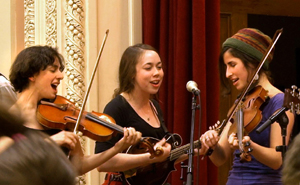Orchestras Part V
I had originally contemplated writing just the four previous posts on orchestra models. But given the currency of this topic both here and abroad, I felt it obligatory to summarize and reiterate some of my points. I also wanted to respond to the many reader comments I have received—which has been a surprising and touching outcome of this blog. Many of you have taken great time, expended much thought, drawn on your life experience, and researched facts to support your often passionately expressed points of view. And I am very grateful for this.
To me, it seems that there is finally a real discussion going on about the American orchestral crisis, not only here on this blog, but on other blogs, in the news media, at industry conferences (the League of American Orchestras recently added a new plenary to its upcoming conference schedule,) and on teleconferences and debates like the recent ones at WQXR and the Cambridge Union.
This outpouring of commentary suggests that solutions to the crisis may be possible, particularly when so many people are putting their heads together and considering the options. Later on in this post, I will respond to some of the more striking, interesting, and pertinent ideas that people have expressed. However, it is because I think a multiplicity of viewpoints is essential to really probe this subject that I’m declining the invitation by my fellow blogger Drew McManus to engage in a video debate with him. This is a topic for more than two voices. It’s about all those who care deeply about the present and future well being of the orchestra and the music it presents.
To further this discussion, I am organizing a virtual symposium of many representative voices. My plan is to invite guest writers to submit an entry to this blog that offers possible solutions to the current orchestral problem—that is, the role of musicians and how to create sustainable symphonic organizations for the future. I hope that Drew would be among the first of these guests. But, in addition, I am extending invitations to representatives from the League of American Orchestras, the Musicians’ Union, orchestra managers, players, board members, donors, composers, consultants, and some of the commentators who appear elsewhere on the Web. This, of course, would be supplemented by the comments of readers. In this way, I think we could aggregate a whole constellation of ideas in one place.
I also wanted to respond to some of the comments I have received. Several of you have advocated for government subsidies for orchestras and other arts organizations in the U.S. William Osborne offered a very interesting defense of government subsidy and how much better a job it does. Among other things, he states that such funding “is very consistent because it is an established part of government budgets.” I worked in the subsidized system in the U.K. for 25 years and it has many advantages but also some major disadvantages. Just look at the recent Arts Council of England draconian cuts of 30% in overall funding to organizations throughout the country.
Mr. Osborne also maintains that “governments see an inherent connection between culture and education and organize their orchestras along those lines.” While that might be true in Europe, it doesn’t seem like an obvious connection here in the US. I suspect American legislators would have a difficult time defending significantly increased arts support especially at a time of great public uneasiness over government deficits and a lack of appetite for tax increases even for more universally acceptable programs.
 So, when readers like NYMike writes that comparing European and American orchestras is like comparing “apples to automobiles,” I have to disagree. Although the former receive government subsidies and the latter require private support, the two models are directly comparable. In the States, the government provides indirect subsidy for the work of charitable organizations through tax breaks, which means that 40% of any private donations are tax deductible. It is still a subsidy, but the donor gets to decide which cause will benefit from it. The system in Europe is also based on subsidy, and the funds are also derived from taxation but dispersed centrally through a government agency to organizations that the government selects. The main difference is that European organizations do not have endowments as part of this financial mix. And they seem to survive perfectly well without.
So, when readers like NYMike writes that comparing European and American orchestras is like comparing “apples to automobiles,” I have to disagree. Although the former receive government subsidies and the latter require private support, the two models are directly comparable. In the States, the government provides indirect subsidy for the work of charitable organizations through tax breaks, which means that 40% of any private donations are tax deductible. It is still a subsidy, but the donor gets to decide which cause will benefit from it. The system in Europe is also based on subsidy, and the funds are also derived from taxation but dispersed centrally through a government agency to organizations that the government selects. The main difference is that European organizations do not have endowments as part of this financial mix. And they seem to survive perfectly well without.
However, here is the main point: Whatever the source of orchestras’ funding, the most important question is how they use those resources, how they are able to sustain their operations and make a beneficial contribution to their communities.
R.W.F. asked: “Is there not perhaps a chance that there has also been a very poor crop of orchestra managers taking the helm at these orchestras? You seem to suggest that management has performed perfectly during all of this and that management is always right through out of this.” In fact, throughout my writing, I have been an equal opportunity critic, commenting on managers and boards as well as musicians. I wrote this:
Many people criticize the unions for causing the escalation of costs and, ultimately, the current dismal state of affairs. This is unfair because, at the end of every negotiation, two parties sign the agreement – management and the union, and it is management and of course the boards, that must take full responsibility.
…And this:
Since Boards bear fiduciary responsibility for their organizations, the question has to be asked: what has been their contribution to this situation? Where have they been during all of this? Well, lulled by ever-increasing private support for many years, they have been complicit in sanctioning excessive pay demands, agreeing to excess draws on endowment, and signing off on defined benefit plans which, down the road, became financial monsters of unfunded liability.
Then, too, some of you have taken me to task for not supporting the notion of musicians being paid well. Bill Anderson, for example, wrote: “They are talented, complex, intelligent, driven, thick-skinned (by need) artists who deserve to be well paid in accordance with the level of orchestra they are in.” Jason responded as I do: “…that the level of compensation received by top-tier orchestra musicians is, in the current orchestral system, unsustainable.” I have no argument with musicians—or indeed managers—being well compensated. However, their level of compensation cannot come at the expense of an orchestra’s existence. And, at the end of the day, what’s important is the benefit they provide to their communities.
Finally, I’ve been asked (by MNJohn for example) what New England Conservatory is doing to “insure that musicians will not only have a job when they graduate, but one that will pay a living wage not only when they are in their 20’s and single but in their 40’s with families?”
We are preparing our students for a difficult environment out in the “real world.” Just being an excellent performer is not going to be enough and we’re telling them that. We are also equipping them with more skills to cope with that reality. We have an outstanding Liberal Arts program that helps students develop their intellectual, professional and creative potential from creative writing to acting classes. We have a Contemporary Improvisation curriculum that is unlike anything at any other music school and encourages collaborations across the school.
It brings together a wide range of students who are eager to explore many genres of music and their own creative facility. This will make them enormously versatile and flexible as professionals.
We also have an extraordinary Community Performances and Partnerships Program in which several hundred of our students engage annually with approximately 20,000 people in the Boston area. They learn how to speak to, perform and teach for public school pupils, seniors, the handicapped and the homeless.
Then, there’s our Abreu Fellows Program at New England Conservatory in which we are training 10 post-graduate musicians a year to become leaders in community music schools modeled after the El Sistema program in Venezuela. The first class of Abreu Fellows alumni are currently out in the field doing stellar work at nucleos in Juneau, Alaska; Queens, NY; Durham, NC; Atlanta; Philadelphia; Los Angeles and right here in Boston.
Indeed, one of them, Lorrie Heagy, was chosen Alaska Teacher of the Year. You can read more about it here.
Finally—and I am particularly proud of this—we have our new Entrepreneurial Musicianship program, which addresses the need young musicians will have to take charge of their careers and develop skills needed to create a gratifying life in music.  Entrepreneurial Grant recipient project ‘Acoustica/Electronica”
Entrepreneurial Grant recipient project ‘Acoustica/Electronica”
The program includes classes, experiential work, grants, and projects that cultivate creative and critical thinking, communication proficiency, financial management, programming, marketing, and self reliance. [Check out these links for more information:
Trust The Power of the Young and Entrepreneurship.]
To summarize, there is a major crisis facing the orchestras in this country. The whole subject has never been discussed openly and candidly. This means all stakeholders – management, Trustees, community leaders, and… most definitely the musicians, discussing the issue and engaging in problem solving. The field has been in denial and we are now faced with a situation where orchestras are lining up declaring their financial insolvency. Detroit and Philly are just the most prominent and there will be others. The analysis is irrefutable. Audiences are dwindling (down 29% over 10 Years), the financial model is not sustainable. Endowments are depleted. Earned income is a fraction of what is was. There is greater and greater reliance placed on increasing the generosity of exhausted donors. Labour relations are antiquated. And orchestras lack legitimacy in their own communities. It is a confluence, a perfect storm of contributing factors that declare the conventional orchestra model is broken and needs changing. We can either spend the next few years blaming one another and watch the whole field slip quietly away or we can do something about it together. And, surely, that is our charge. We need the courage, the energy, and the vision to reinvent and rejuvenate. Just as the London Symphony and Berlin Philharmonic have done. They are leaner, more flexible, more productive, more responsive to their communities and…sustainable. We have so much to learn from them.





No comments yet.
Add your comment